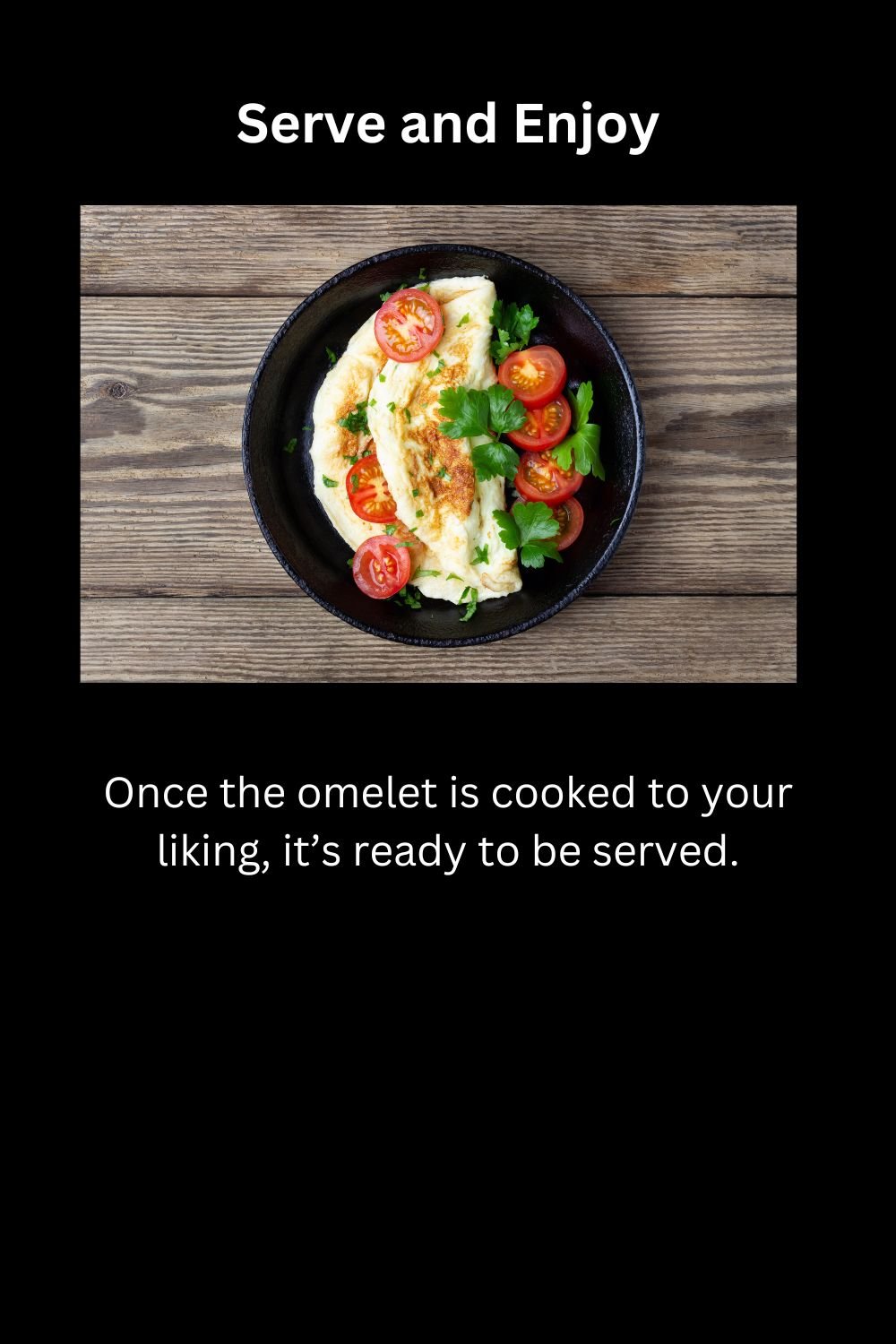Making an omelet is a simple and rewarding culinary skill that anyone can master. Follow these easy steps to create a delicious and fluffy omelet every time.

Gather Your Ingredients

Before you start, make sure you have all the necessary ingredients.
- 2-3 large eggs
- 1-2 tablespoons of milk or water
- Salt and pepper to taste
- Butter or oil for the pan
- Fillings of your choice (cheese, vegetables, ham, etc.)
Prepare Your Fillings
Chop and prepare any fillings you plan to add to your omelet.
- Vegetables: Dice vegetables like bell peppers, onions, mushrooms, and tomatoes.
- Meats: Slice or chop meats like ham, bacon, or sausage.
- Cheese: Grate or slice cheese of your choice.
Beat the Eggs
In a medium bowl, crack the eggs and add the milk or water.
- Use a fork or whisk to beat the eggs until they are well combined and frothy.
- Add a pinch of salt and pepper to the eggs and mix well.
Heat the Pan
Choose a non-stick skillet or omelet pan for best results.
- Place the pan over medium heat.
- Add a small amount of butter or oil to the pan and allow it to melt and coat the surface.
Cook the Eggs
Pour the beaten eggs into the heated pan.
- Tilt the pan to spread the eggs evenly across the surface.
- Let the eggs cook undisturbed for a few seconds until they start to set around the edges.
Add Fillings

Once the eggs have begun to set, add your fillings.
- Sprinkle cheese, vegetables, meats, or any other fillings evenly over one half of the omelet.
- Be careful not to overfill the omelet, as it may make it difficult to fold.
Fold the Omelet
Gently fold the omelet in half.
- Use a spatula to lift one edge of the omelet and fold it over the fillings.
- Press gently to seal the edges.
Cook Until Done
Continue cooking the omelet until it reaches your desired level of doneness.
- Allow the omelet to cook for another 1-2 minutes, letting the cheese melt and the fillings heat through.
- If needed, flip the omelet gently to cook the other side for a few seconds.
Serve the Omelet

Once the omelet is cooked to your liking, it’s ready to be served.
- Slide the omelet onto a plate.
- Garnish with fresh herbs or additional toppings if desired.
Tips and Variations
Enhance your omelet-making skills with these additional tips and variations.
- Use fresh ingredients: Fresh vegetables, meats, and cheese can significantly improve the flavor of your omelet.
- Experiment with fillings: Try different combinations of fillings to find your favorite.
- Use herbs and spices: Add herbs like chives, parsley, or basil to the eggs for extra flavor.
- Cook over medium heat: Cooking over medium heat prevents the eggs from browning too quickly and ensures a tender omelet.
Clean Up
After enjoying your omelet, clean up your cooking area.
- Wash the skillet and utensils with warm soapy water.
- Wipe down the countertops and put away any unused ingredients.
Troubleshooting Common Problems
If you encounter any issues while making your omelet, here are some solutions.
- Omelet sticking to the pan: Ensure the pan is well-coated with butter or oil, and use a non-stick skillet.
- Omelet breaking apart: Use a gentle touch when folding and flipping the omelet. Overfilling can also cause it to break.
- Eggs cooking unevenly: Tilt the pan to distribute the eggs evenly and cook over medium heat to avoid hot spots.
Further Tips and Troubleshooting for Perfect Omelets

Creating the perfect omelet takes a bit of practice and attention to detail. Here are some additional tips and common mistakes to avoid to help you refine your omelet-making skills.
Choose the Right Pan
Using the correct pan can make a big difference in your omelet-making process.
- Size: A small to medium-sized non-stick skillet (8-10 inches) is ideal for making omelets. A larger pan may cause the eggs to spread too thinly.
- Non-Stick: A non-stick surface helps prevent the omelet from sticking and makes flipping and folding easier.
Use Fresh and Quality Ingredients
The quality of your ingredients will significantly impact the flavor and texture of your omelet.
- Fresh Eggs: Fresh eggs yield a better texture and taste.
- High-Quality Fillings: Use fresh vegetables, high-quality meats, and good cheese to enhance the overall flavor.
Beating the Eggs
Properly beaten eggs are key to a fluffy omelet.
- Whisk Thoroughly: Whisk the eggs until the yolks and whites are completely combined and the mixture is slightly frothy.
- Incorporate Air: Beating the eggs well helps incorporate air, resulting in a lighter and fluffier omelet.
Cooking Temperature
Maintaining the right temperature is crucial for a well-cooked omelet.
- Medium Heat: Cook your omelet over medium heat. High heat can cause the eggs to brown too quickly and become tough.
- Even Heat Distribution: Ensure the heat is evenly distributed across the pan to avoid hot spots.
Timing and Patience
Patience is key to making a perfect omelet.
- Let it Set: Allow the eggs to set slightly before adding fillings. This helps prevent the fillings from sinking to the bottom.
- Gentle Folding: Use a gentle touch when folding the omelet to avoid breaking it.
Common Mistakes and How to Avoid Them
Overcooking the Eggs
- Problem: Overcooked eggs can become tough and rubbery.
- Solution: Cook the omelet just until the eggs are set. The residual heat will continue to cook the eggs after you remove them from the pan.
Underfilling or Overfilling
- Problem: Too little filling can make the omelet bland, while too much can make it difficult to fold and cook evenly.
- Solution: Use a balanced amount of fillings, distributing them evenly over one half of the omelet.
Omelet Sticking to the Pan
- Problem: The omelet sticks to the pan, making it difficult to flip or fold.
- Solution: Use a non-stick skillet and ensure the pan is well-coated with butter or oil before adding the eggs.
Uneven Cooking
- Problem: The omelet cooks unevenly, with some parts being overcooked and others undercooked.
- Solution: Tilt the pan to distribute the eggs evenly, and cook over medium heat to ensure even cooking.
Breaking Apart When Folding
- Problem: The omelet breaks apart when you try to fold it.
- Solution: Use a spatula to gently lift and fold the omelet. Avoid overfilling, as this can make folding more difficult.
Improperly Seasoned
- Problem: The omelet lacks flavor due to insufficient seasoning.
- Solution: Add a pinch of salt and pepper to the beaten eggs before cooking. You can also sprinkle additional seasonings or herbs to taste.
Additional Tips for a Perfect Omelet
Pre-Cook Fillings
- Vegetables: Sauté vegetables like mushrooms, onions, and bell peppers before adding them to the omelet. This ensures they are fully cooked and enhances their flavor.
- Meats: Cook meats like bacon, sausage, or ham beforehand to ensure they are properly cooked and add a delicious, savory element.
Use a Lid
- Cover the Pan: If you prefer a fully cooked omelet, you can cover the pan with a lid for a minute or two. This helps cook the top of the omelet without flipping it.
Experiment with Flavors
- Herbs and Spices: Add fresh herbs like chives, parsley, or basil to the egg mixture for added flavor.
- Cheese Varieties: Try different types of cheese such as cheddar, feta, or goat cheese for unique taste experiences.
Perfecting the Flip
- Practice: Flipping an omelet takes practice. Start with smaller omelets and work your way up as you gain confidence.
- Spatula Technique: Use a flexible spatula to lift the edge of the omelet and quickly flip it with a swift wrist motion.
Conclusion
Making a perfect omelet is a combination of using the right techniques, choosing quality ingredients, and practicing patience. By following these tips and avoiding common mistakes, you’ll be able to create delicious and visually appealing omelets every time. Enjoy experimenting with different fillings and flavors to find your perfect omelet combination.
